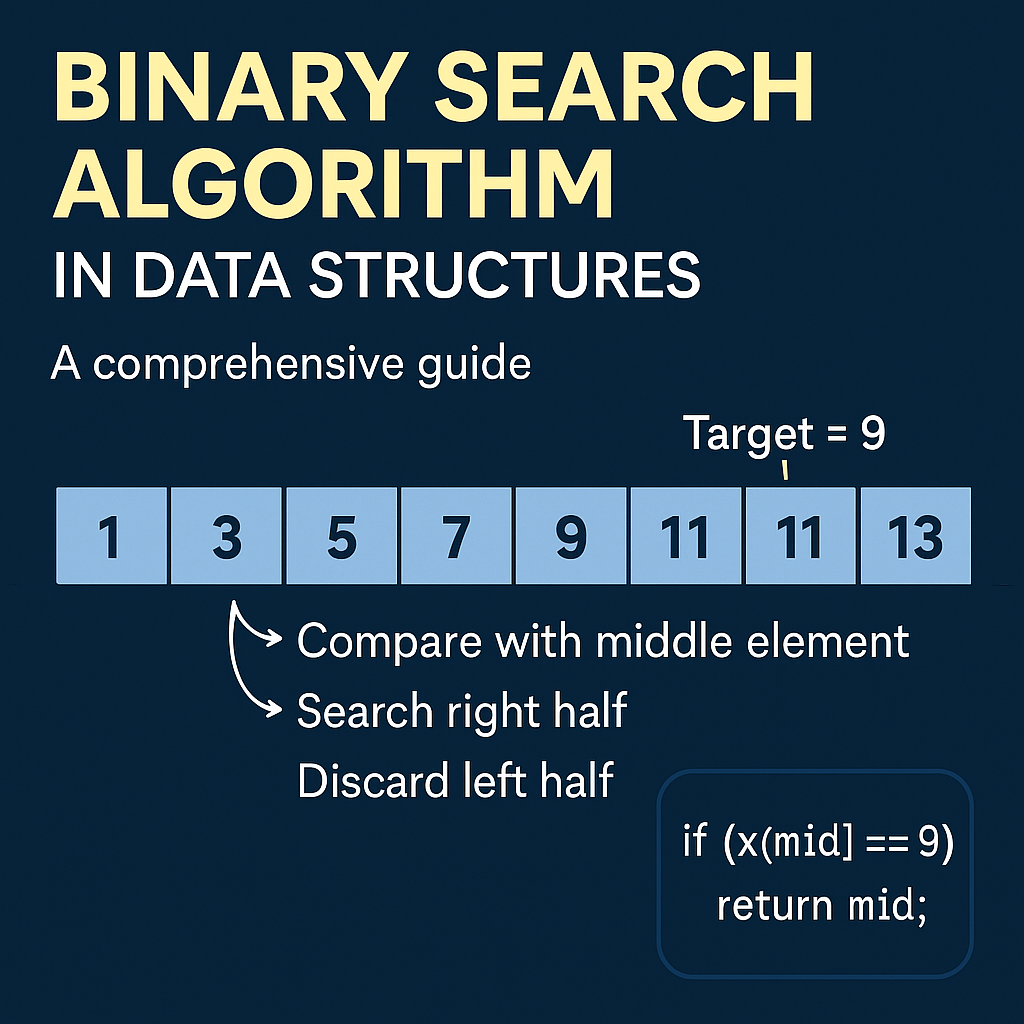binary-search-Data-Structures-Algorithms-for-Beginners
admin
Illustration of Binary Search Algorithm in Data Structures with C code and step-by-step logic flow
Binary Search Algorithm in Data Structures: A Comprehensive Guide
Introduction
Binary search is one of the most efficient and widely-used searching algorithms in computer science. Its efficiency lies in its ability to divide the search space in half with each iteration, making it incredibly fast compared to linear search. In this article, we’ll delve into the concept of the binary search algorithm, how it works, its implementation in C, and its practical use cases.

What is Binary Search?
Binary search is a technique for finding a specific element in a sorted array. It compares the target value to the middle element of the array and decides which half of the array to continue searching in, based on whether the target is smaller or larger than the middle element. This process repeats until the element is found or the search space is empty.
Key Features of Binary Search
- Efficient: Reduces the search space by half at each step, with a time complexity of .
- Requires Sorting: The array must be sorted before applying binary search.
- Iterative and Recursive: Can be implemented both iteratively and recursively.
How Does Binary Search Work?
- Start by defining the lower bound (lb) as the first index and the upper bound (ub) as the last index of the array.
- Calculate the middle index:
-
Compare the target value () with the middle element:
- If the middle element matches the target, return its index.
- If the target is smaller, search in the left half by updating .
- If the target is larger, search in the right half by updating .
- Repeat the process until the target is found or .
Binary Search Implementation in C
#include<stdio.h>
#include<conio.h>
void main() {
int x[10] = {2, 4, 5, 6, 7, 8, 9, 18, 30, 68};
int lb = 0, ub = 9, mid, sno;
clrscr();
printf("\nEnter the number to search: ");
scanf("%d", &sno);
while (lb <= ub) {
mid = (lb + ub) / 2;
if (x[mid] == sno) {
printf("Element found at position = %d", mid + 1);
return;
}
if (sno < x[mid]) {
ub = mid - 1;
} else {
lb = mid + 1;
}
}
printf("\nElement not found");
getch();
}
Explanation of the Code
-
The program begins with a sorted array
x[10]containing 10 elements. - The user inputs the number they want to search for.
-
The algorithm iteratively calculates the middle index, compares it with the target, and adjusts the bounds (
lbandub) accordingly. - If the element is found, the position is displayed. If not, an "Element not found" message is printed.
Advantages of Binary Search
- Fast Searching: Significantly faster than linear search for large datasets.
- Deterministic: Guarantees a result if the element exists in the array.
- Reduced Comparisons: Eliminates half of the elements in each iteration.
Use Cases of Binary Search
- Finding a Word in a Dictionary: Binary search can quickly locate a word in a sorted dictionary or list of terms.
- Search in Sorted Data: Used in databases or files with ordered records.
- Locate a Letter in the Alphabet: For instance, finding the position of a letter in:
- Debugging Tools: Binary search is used to identify bugs in large codebases by systematically narrowing down the source of the issue.
Limitations of Binary Search
- Requires Sorted Data: The array must be sorted before applying binary search.
- Not Suitable for Dynamic Data: If the dataset is frequently updated, maintaining the sorted order can be costly.
Conclusion
Binary search is a foundational algorithm in computer science, providing a fast and efficient way to search through ordered data. With its simple implementation and wide-ranging applications, it remains an essential tool for developers and data scientists. From locating a letter in the alphabet to optimizing database queries, binary search continues to play a pivotal role in solving real-world problems.
If you’re looking to improve your programming skills, mastering the binary search algorithm is a great place to start!
Optimize Your Learning
- Practice implementing binary search in various programming languages.
- Explore recursive implementations for a deeper understanding.
- Experiment with edge cases, such as empty arrays or arrays with duplicate elements.
By doing so, you'll gain a comprehensive understanding of one of the most efficient searching techniques in data structures.
Table of content
- Arrays
- Structures
- Polynomials
- Stacks
- Linked Lists
- Queues
- Searching and Sorting
- Trees